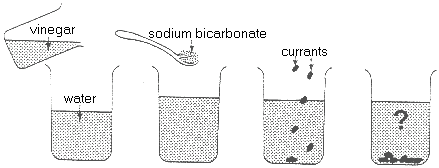
ACIDS AND BASES
Make an Indicator from Red Cabbage
- Safety Rules:
- Parent supervision
- Take care with fire or heat
- Take care with a knife
- Materials you need are:
- a stove
- red cabbage
- a knife
- a chopping board
- a saucepan
- a spoon
- water
- a strainer
- a container
- an eyedropper
Cut up 2 or 3 red cabbage leaves into small pieces. Place these into a saucepan and cover with hot tap water. Boil the mixture for 5 to 10 minutes. Allow it to cool and strain it, keeping the liquid.
You have made an indicator that changes colour when acids or bases are added to it. Use an eye dropper to do this.
Test Household Acids and Bases
- Safety Rules:
- Parent supervision
- Take care with household chemicals (Some may be poisonous)
- Wear gloves and goggles
Use a red cabbage indicator or a pool pH test kit to test household chemicals to find out whether they are acidic, neutral or basic. Try vinegar, Coke, tomato sauce, sodium bicarbonate (also called bicarbonate of soda or baking soda), epsom salts (also called magnesium sulphate), soap, toothpaste, black tea or coffee, salty water and many others.
Alka-Seltzer Rocket
- Safety Rules:
- Parent supervision
- Take care with Alka-Seltzer (It is poisonous)
- Wear gloves and goggles
- Do it out doors as it is messy and loud
- Materials you need are:
- an empty film canister with a tightly-fitting lid
- an Alka-Seltzer antacid tablet (from the supermarket)
- water
Fill the film canister one-third full with water. Drop 1/2 of the Alka-Seltzer tablet into the water and quickly put the lid on tightly. Turn the canister upside down on the ground. Stand back and wait.
The Alka-Seltzer tablet produces a lot of gas on reacting with the water. The gas blows the lid off the container which should lift up like a rocket. Try using cardboard to make a cylinder-shaped rocket around your film canister.
Balloon Blower
- Materials you need are:
- a container with a narrow opening
- a balloon (the round type)
- vinegar
- sodium bicarbonate (also called baking soda)
- a teaspoon
Put about two teaspoons of sodium bicarbonate and some vinegar in the container. Quickly put the balloon over the mouth of the container to catch the gas produced.
The gas produced is carbon dioxide and should inflate the balloon.
Floating Currants
- Materials you need are:
- a clear container
- vinegar
- sodium bicarbonate (also called baking soda)
- a teaspoon
- currants
-

Into the transparent container, put about 250mL and about 50mL vinegar. Add a heaped dessertspoonful of sodium bicarbonate. Then quickly drop about six currants into the mixture. If necessary, add more sodium bicarbonate and push the currants under the water.
The mixture produces carbon dioxide gas. Bubbles of the gas should make the currants rise up in the water.
Make 'Rubbery' Eggs
Put a raw egg in an icecream container and cover it with vinegar. Leave for a few days.
The vinegar should dissolve the eggshell and the eggs should feel like rubber. The reaction is :
Acetic acid (Vinegar)+ Calcium carbonate (Eggshell) ![]() Carbon dioxide + Calcium acetate salt + Water
Carbon dioxide + Calcium acetate salt + Water
This also works with cleaned chicken bones.
Make a Bath Bomb
- Materials you need are:
- sodium bicarbonate (also called baking soda)
- citric acid (from the supermarket)
- a sieve
- 2 mixing bowls
- 2 spoons
- a container as a mould
It is essential that all the materials and the weather are very dry. Sieve one-and-a -half cups of sodium bicarbonate and a cup of citric acid into fine powder into a bowl. Stir well. Divide the stirred mixture into your moulds and compress it with your fingers. Let it sit for 24 hours in a dry place and then turn out your moulds. Test them in a tub or bath of water. You can add a few drops of food colouring or fragrant oils before setting if you like.
When the dry mould is placed in water, the acid (citric acid) and the base (sodium bicarbonate) should react.
Make Sherbet
- Materials you need are:
- icing sugar
- sodium bicarbonate (also called baking soda)
- citric acid (from the supermarket)
- a container
- a spoon
Add the following ingredients to a cup: 3 teaspoons of icing sugar, 1/2 teaspoon of citric acid and 1/4 teaspoon of baking soda. Mix the ingredients thoroughly and taste the mixture.
It should froth on your tongue when it comes in contact with your saliva because the acid reacts with the carbonate to make salt, water and carbon dioxide gas. It should also tingle because of the citric acid, and taste sweet because of the sugar.